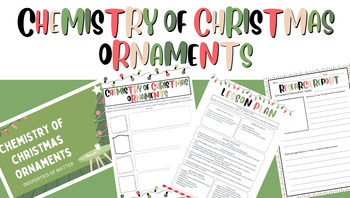Christmas Resource Bundle - All Editable - Chemistry of Christmas ornaments
ScienceTeachHub
0 Followers
Grade Levels
6th - 9th, Homeschool
Subjects
Resource Type
Standards
CCSSRST.6-8.2
CCSSRST.6-8.3
CCSSRST.9-10.3
NGSSMS-PS1-2
NGSSHS-PS1-3
Formats Included
- Zip
ScienceTeachHub
0 Followers
Products in this Bundle (3)
Bonus
Christmas Ornament Research Assignment/Homework task
Description
Unwrap the magic of chemistry this holiday season with our comprehensive "Chemistry of Christmas Ornaments Exploration" resource bundle! This engaging and festive collection is designed help you to infuse your chemistry class with the enchantment of the holidays while providing students with a deep understanding of the science behind their favorite ornaments and the properties of matter. All resources are able to be edited and printed by you! Made by a science educator for educators! Bundle includes
- Lesson Plan
- Powerpoint presentation
- Handout
- Bonus Homework/Assignment Resource
The instant downloads are much better quality than the screenshots of the previews!
Total Pages
Answer Key
N/A
Teaching Duration
1 hour
Last updated 6 months ago
Report this resource to TPT
Reported resources will be reviewed by our team. Report this resource to let us know if this resource violates TPT’s content guidelines.
Standards
to see state-specific standards (only available in the US).
CCSSRST.6-8.2
Determine the central ideas or conclusions of a text; provide an accurate summary of the text distinct from prior knowledge or opinions.
CCSSRST.6-8.3
Follow precisely a multistep procedure when carrying out experiments, taking measurements, or performing technical tasks.
CCSSRST.9-10.3
Follow precisely a complex multistep procedure when carrying out experiments, taking measurements, or performing technical tasks, attending to special cases or exceptions defined in the text.
NGSSMS-PS1-2
Analyze and interpret data on the properties of substances before and after the substances interact to determine if a chemical reaction has occurred. Examples of reactions could include burning sugar or steel wool, fat reacting with sodium hydroxide, and mixing zinc with hydrogen chloride. Assessment is limited to analysis of the following properties: density, melting point, boiling point, solubility, flammability, and odor.
NGSSHS-PS1-3
Plan and conduct an investigation to gather evidence to compare the structure of substances at the bulk scale to infer the strength of electrical forces between particles. Emphasis is on understanding the strengths of forces between particles, not on naming specific intermolecular forces (such as dipole-dipole). Examples of particles could include ions, atoms, molecules, and networked materials (such as graphite). Examples of bulk properties of substances could include the melting point and boiling point, vapor pressure, and surface tension. Assessment does not include Raoult’s law calculations of vapor pressure.





